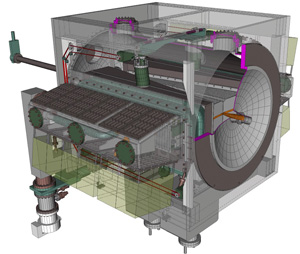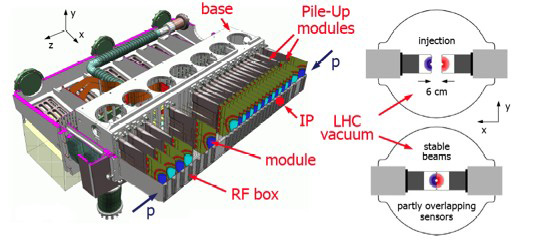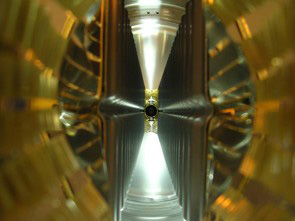B-mesons produced by colliding proton beams live for just a millionth of a millionth of a second, during which they travel over one millimetre before decaying into other particles. The VELO has been designed to perform an accurate measurement of their decay positions.

The sub-detector consists of two rows of half-moon-shaped silicon sensors, each 0.3 mm thick. A small cutout in the centre of sensors allows the main LHC beam to pass through unimpeded. Charged particles produced by proton collisions traverse the silicon and generate electron-hole pairs; these electrons are sensed using application specific-electronics. During physics data-taking, the silicon sensors are positioned either side of the LHC beam, at a distance of 7 mm.
Custom-made bellows enable the VELO to retract from its normal (physics) position to a distance of 35 mm. This flexibility is crucial during the everyday operation of the LHC beam as the VELO must be retracted during injection of protons into the LHC and at the end of every fill. This protects the VELO from possible damage during critical beam injection and dumping phases of the beam operation, and also permits the LHC operators to inject the beam without interference from the VELO.

The whole VELO system is placed inside the LHC vacuum pipe in order to place the sensors as close to the primary interactions as possible. To protect the integrity of the primary LHC vacuum system, the sensors are separated from the beam volume by a 0.3 mm aluminium shield or “foil”. The detectors and the read-out electronics are constructed from radiation resistant components, and a CO2-based refrigeration system keeps the electronics cool. Signals from the detector are transported outside the vacuum system for analysis through 22,000 cables.

The VELO is the main tracking device before the magnet and its data are heavily used in the trigger. The readout is analog and uses 40 m copper cables. Zero suppression and cluster finding occurs on TELL1 boards behind the radiation shield. The TELL1 board contains links to the data acquisition system.
